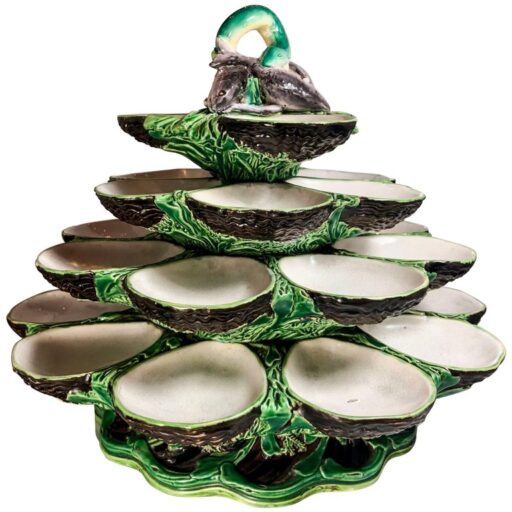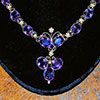Decorative Periods
Georgian 1714-1837
The Georgian period of jewelry was popular during the reign of England’s Kings George I, II and III. During this time the aristocracy was known for wearing a large amount of jewels.
As with other early era jewelry all Georgian jewelry pieces are handmade. This means most pieces didn’t appear perfect and had some form of irregularity. Stones often looked cruder than those of later eras. This era also focused on jewelry that could come apart to form separate pieces. For example, a necklace could be designed to form two bracelets or a bracelet could become a brooch and earrings.
The Georgian Period can be described in three distinct styles:
- Rococo – Curvilinear, over elaborate, decorative floral,shells, Scrollwork patterns, and jeweled flowers.
- Gothic Revival – Foil=Set gems over gold or silver foil with their side backs enclosed with metal.
- Neoclassical – Shapes are generally more geometric, scrolls and garlands were a popular theme. Decoration tended to be on the light restrained side.
Victorian 1837-1901
This time period spans the reign of Queen Victoria – an era when the British Empire was in its prime. Because of this, the historical events and societal preferences of the British Empire, and of Victoria herself, informed the fashion trends for the entire world and made a lasting impression on the history of jewelry.
Victorian jewelry is characterized by bold pieces featuring heavy gold designs. Ironically, in the early part of the Victorian period, gold was very rare and this "illusion" of opulence was created through intense craftsmanship where a small amount of gold could be used to its best advantage. This elaborate detail work is one of the reasons Victorian era jewelry is so sought after.
The death of Queen Victoria's husband, Prince Albert, in 1861, brought about the fashionable "mourning jewelry" characterized by heavy, dark stones such as jet, onyx, amethyst and garnet. In this sentimental time, locks of hair were often used as an integral part of jewelry and keepsake lockets, brooches and cameos gained in popularity, as well.
During the latter part of the Queen's reign, the archaeological discoveries of Etruscan jewelry became a great source of inspiration for Victorian era jewelers. Also during this period, we begin to see trends towards a modem society and more modem jewelry. The dawning industrial age, with its growing affluence, coinciding with the discovery of abundant diamonds in South Africa created a desire for more opulent and ostentatious pieces.
Edwardian 1901 -1910
Jewelry of the Edwardian Period was greatly influenced by King Edward VII, Victoria's son, and his bride, Alexandria, who cultivated a new society more focused on elegance and sophistication. Such inventions as the airplane and the movie industry during this period created a collective desire for a more cosmopolitan way of life.
After the Victorian obsession with heavy gold pieces, the Edwardian period is marked by a dramatic turn toward light, airy designs and radiant white materials such as platinum, diamonds, pearls and white sapphires. Women embraced the new fashion of upswept hair and wore decorative tiaras and elaborate, dangling earrings to accentuate the trend.
Alexandria's own personal fondness for "dog collar" necklaces, such as those worn by India princesses, made choker necklaces a trend that has endured for many years. King Edward enjoyed sports himself and encouraged the use of sporting motifs in jewelry.
Art Nouveau 1910 – 1919
Up to this point in history, jewelers were focused on creating pieces that best displayed the most sough-after stones and metals of the time. The Art Nouveau period created a new role for jewelers as artists, creators and visionaries. They considered the aesthetic of the preceding classical period to be "fussy" and superficial and made a dramatic shift to natural motifs and organic shapes.
As a result, Art Nouveau jewelry often featured dragonflies, snakes and flowers and was created using natural materials such as tortoise shell and horn. While Victorian and Edwardian trends were driven by the opulence of diamonds or gold, the Art Nouveau era embraced a wide-range of more semi-precious stones such as opals, moonstone and citrine.
Art Deco 1919 – 1939
No other era in the history of jewelry can still be so strongly recognized in current trends as that of the Art Deco style. Brought about by the artistic movement of cubism, Art Deco jewelry features strong geometrical patterns, modem ultra-clean lines and angular shapes making it one of the most easily recognized genres.
Art Deco jewelry is often described as "architectural" in appearance and often features gemstones being cut in bold geometric shapes, such as the emerald cut, many of which are still very much in demand today. Another characteristic of the Art Deco movement was to combine bold, contrasting tones like black and white to create a striking and modem look. Long beaded necklaces with tassels such as those worn by the fashionable "flappers" were very popular, as well.
Retro Modem 1940 – 1950
The style of the Retro Modem era was greatly influenced by World War II which began in 1939. Suddenly, women were brought into the work-force to lend support and sweeping social and economic changes remained well after the war ended in 1945. The influence of Hollywood was at an all time high as the world looked to movies as a welcome escape from the realities of wartime.
The glamorous looks seen on the big screen influenced "larger than life" proportions in jewelry of the time. Pieces were often chunky and featured large colorful gemstones and romantic shapes such as bows, scrolls, flowers, ribbons and ruffles. Gold suddenly regained popularity as platinum was being used in the war effort and was mostly unavailable during this time. Economy-minded women of the 1930's sought out "illusion settings", which made modest-sized jewels look much larger.
The jewelers of this time, such as Harry Winston, Tiffany & Co. Cartier, and Van Cleef & Arpels are still some of the most in-demand and respected in the world.


